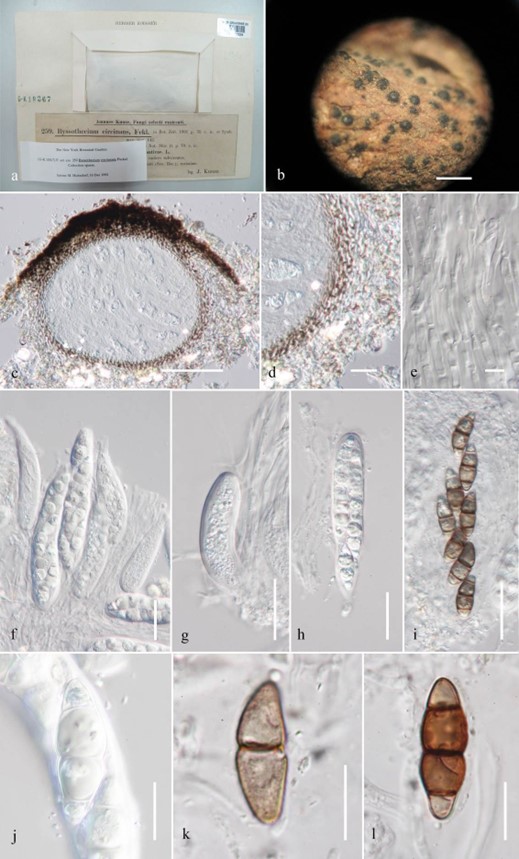Byssothecium circinans Fuckel, Bot. Ztg.19 (no. 35): 251 (1861) Fig. 9
MycoBank number: MB 165669;Index Fungorum number: IF 165669; Facesoffungi number: FoF 06226
Saprobic or parasitic on Medicaginis sativae. Sexual morph: Ascomata pseudothecioid 250– 350 μm high, 200–300 μm diam. ( x = 256.3 × 260.2 μm, n = 10), solitary, scattered, or in groups, immersed, semi-immersed to erumpent, globose to subglobose, black, apex with a short papilla. Peridium 16–40 μm wide, coriaceous, consisting of thick-walled, brown cells of textura angularis. Hamathecium 2–5 μm wide comprises pseudoparaphyses, embedded in mucilage, branching, septate and anastomosing between and above the asci. Asci 54–69 μm × 8–13 μm ( x = 61.3 × 11.3 μm, n = 10), 8-spored, bitunicate, fissitunicate, cylindro-clavate, slightly curved when immature, pedicellate. Ascospores 35–44 μm × 12–16 μm ( x = 41.2 × 14.5 μm, n = 10), uni- to bi-seriate, fusiform, hyaline when immature, dark brown at maturity, trans-septate and variously ornamented. Asexual morph: undetermined.
Material examined – GERMANY, Europe, F. rhen. 730c, on Medicago sativa (Fabaceae), Fuckel, (B70 0014084, isotype); Fungi rhenani 730 (G-K 18364); Herbier Boissier 339 (G-K 18366); F. sel, exs. 259, on Medicago sativa (Fabaceae) (G-K 18367).
Economic significance – The genus Byssothecium has been reported to cause leaf spots on Quercus sp. (Fagaceae) in Iran (Pourmoghaddam et al. 2015).

Figure 9 – Byssothecium circinans (G-K 18367) a, b Herbarium specimen and habit on host. c Section of ascoma. d Peridium. e Hamathecium. f Asci embedded in pseudoparaphyses. g–i Asci. j–l Ascospores. Scale bars: b = 500 μm, c = 100 μm, d, e, g, j–l = 20 μm, f, h–i = 50 μm.
